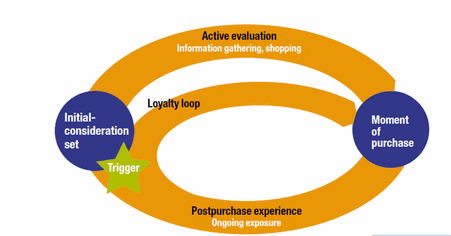The dealer plays a critical role in influencing a car buyer's purchase decision with the test drive, dealer website and a look around the vehicle in a showroom playing a fundamental part, whatever brand they are considering.
Research commissioned by St Ives Group also revealed social media interaction plays a tiny part in winning buyers.
1,001 people were asked a range of questions on their recent purchase, from the make and model they bought and how that compared to cars they had previously owned, to the detail of what information they were looking for at each step of the decision-making process.
The buying journey

Triggers
Consumers have lots of triggers and it’s unlikely to be a single factor that causes consumers to be triggered into considering a purchase:
¦ Desire for a new car – 58%
¦ Cost/economic factors – 46%
¦ Change in situation – 30%
¦ External factors – 17%
¦ Males are more likely to be the impulsive car buyers, while females are more likely to take the decision to change their car for the repair bills.
¦ A change in circumstances, or coming into money is more likely to result in a car purchase for younger consumers.
¦ Repair bills are more likely to trigger 35-54 year olds than other age groups and a simple desire for a newer car increases with age.
¦ Only younger males and older females are the consumers who are more concerned about economy when buying a car.
The journey to a new car
On average it takes between two and eight weeks for a buyer to work through the evaluation stage, which is the same regardless of which type of car consumers buy.
And low cost or value car buyers do all their research before visiting a dealership, meaning when they arrive at a dealer they are ready to make the purchase, the research said.
Mainstream car buyers take a very similar journey to low cost/value car buyers, taking a few more steps, but are also ready to make the purchase when they visit a dealer
Premium car buyers take a different journey to other buyers, visiting the dealership earlier, but not prepared to buy at that point. Instead they seek validation of their choice, as well as hunting for a deal.
Paanisha Lad, content and social media marketeer at St Ives Group, said: "Ultimately it is the dealers who play the final influencing role.
"The test drive and visiting the dealership’s website are the steps on the journey that have the most influence on the car consumers buy, regardless of whether they are low cost/mainstream or premium car buyers
"When people visit a dealership website (not an OEM website) the technical spec is the most important thing (outside of price), but when they visit the dealership, the physical size of the car is more important – hence why they bring prams, pushchairs and golf clubs with them.
"The fact that consumers look at other cars on the road for ideas about their next car shows how much they are searching for inspiration.
"Couple this with that fact that nearly one in 10 are triggered by an advert shows the important role marketing has to play throughout the lifecycle of car ownership.
Throughout the purchase process social media plays a very, very small role in the purchase process (if any at all) highlighting that this is an in-life tool, not something that can acquire new customers."
Customer segmentation
Low cost/value car buyers:
The research showed the one fact low cost/value consumers know at the start of the journey is how much they can spend.
This then dictates the journey, often going to Auto Trader and putting in the price brackets to whittle down their options to something that fits their needs.
"They are generally the least sophisticated 'searchers' focusing their efforts on the obvious sources such as Auto Trader, but also use Top Gear’s website more than the mainstream buyers because this is a name that resonates rather than them having to expend the effort finding different sources," said Lad.
They also take the least number of steps along the journey compared to other buyers, but despite this the journey isn’t any quicker, suggesting they take more time over each decision than, say, a premium car buyer who takes a lot more steps in the same time.
Mainstream car buyers:
The mainstream - or average car buyer - takes only a slightly different journey to low cost buyers: they are more likely to talk to their friends about the car that they own, highlighting the importance of word of mouth to these consumers.
Ebay is a source of information for these buyers with a third of mainstream consumers visiting Ebay during the active evaluation phase, as well as Auto Trader.
94% of mainstream buyers take a test drive, and this is the most influencing factor in a purchase.
"If you get them in the car, they will be ready for a sale, as this tends to happen at the end of their purchase journey."
Premium car buyers:
The premium car buyer has a distinctly different purchase journey than any of the other car buyers.
They are much more sophisticated 'searchers' taking the most steps along the journey of all buyers. And the optional extras are far more important to these buyers than any other buyers
Also, premium buyers are the most likely to visit the OEM website, compared to other buyers who only tend to visit the dealerships sites.
"Importantly they visit the dealer much earlier in the purchase journey as part of their exploration.
"This is, again the most influential step on the journey, but it is merely a step along the journey and they will not be ready for the purchase during the visit.
"What they would value at this point is directions for external validation that their purchase is the right one for them.
"So get your sales team to present independent reviews of the vehicle in question as this is their next step on the journey."






















Jerry Horwood - 31/10/2013 18:23
Agreed the part played by the OEM and dealer website is vital, but how are they found? Guess what drives SEO... Social Media! SM may not be directly relevant to high volumes of transactions, but it is a massively important factor in driving traffic to sites